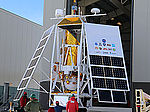 Last year it stayed on the ground due to bad weather conditions, but this year it went up last Thursday December 8th at 21.30 hours: the STO2 telescope, that will peer into molecular clouds in the universe where stars are born, while hanging on a giant NASA balloon, 40 kilometers above Antarctica.The NASA balloon that carries the measuring instruments to this altitude makes use of the circular polar vortex, a stable airflow on which the balloon can circulate with for one or more rounds of about 14 days each. This will allow scientists to carry out observations for a period of two weeks before they find the balloon at nearly the same location again.
Last year it stayed on the ground due to bad weather conditions, but this year it went up last Thursday December 8th at 21.30 hours: the STO2 telescope, that will peer into molecular clouds in the universe where stars are born, while hanging on a giant NASA balloon, 40 kilometers above Antarctica.The NASA balloon that carries the measuring instruments to this altitude makes use of the circular polar vortex, a stable airflow on which the balloon can circulate with for one or more rounds of about 14 days each. This will allow scientists to carry out observations for a period of two weeks before they find the balloon at nearly the same location again.
STO2 has been developed under the leadership of the University of Arizona and contains vital contributions from SRON Netherlands Institute for Space Research (Utrecht and Groningen) and TUDelft.
SRON and TUDelft built the sensors in the telescope’s heart.These are three receivers for 1.4, 1.9 and 4.7 terahertz respectively. The terahertz sensors will scan a part of the Milkyway
(about 10 degrees wide) for traces of oxygen. To astronomers, the oxygen spectral line means a temperature of about 300 Kelvin. In contrast with a background of 100 Kelvin, the local heat indicates the birth of a star.
